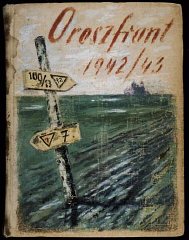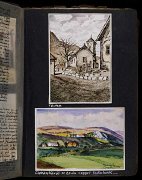|
|

|

|
Album cover featuring a road sign with the Hungarian Labor Service company number 109/13 posted in a muddy wasteland. The Jewish labor servicemen were forced to construct roads on these muddy fields to accommodate the advance of the Hungarian ... See photograph |
ART AND SURVIVAL: GYÖRGY BEIFELD'S VISUAL MEMOIR FROM THE RUSSIAN FRONT, 1942-1943 |
||||
|
|
The wind was blowing icicles into our eyes. Our breath got frozen to the fabric we used to cover our faces. One's legs were in great pain dragging the body…Anyone who got exhausted and sat down for a minute would inevitably freeze to death. That applied equally to men and horses. They lay there next to each other frozen to death, a soldier, a horse, and a Jew. INTRODUCTION |
|
In recent years, the United States Holocaust Memorial Museum has been fortunate to obtain three highly significant collections of documents, photographs, art, and artifacts that illustrate and describe various aspects of the experience of Hungarian Jews during the period between 1933 and 1948. These collections include a handwritten journal of a Hungarian businessman, written while he was imprisoned in the Bergen-Belsen camp during the early months of 1945; a multi-volume diary of a Hungarian physicist and inventor, who reflected at length about the life of Jews in Budapest in the 1930s and 1940s; and lastly, the richly illustrated memoir of a Hungarian Jew who spent more than a year at the eastern front in 1942-1943 as a member of a forced-labor battalion. This last acquisition, the Byfield album, is the focus of this online display. Examine pages from the album by clicking on See artifacts and using the zoom tool to select and magnify areas of the image. |
 |
||
|
See more artifacts Album page |
|
BIOGRAPHY |
|
Read more about Beifeld's visual memoir and explore pages from sections of the album: humor in the Beifeld album; in the labor service; counteroffensive and retreat; assembling the album. |
|
|
|